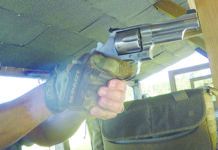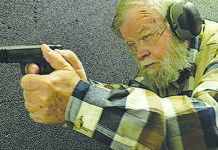All available SKS rifles are either used or surplus. The exception would be companies that offer “new” guns that are weapons assembled from spare parts. We are beginning to see AK-47s made in the USA, so as import lines dry up perhaps new production SKS rifles will be offered in the future. In the meantime, our listed price represents a common if not the higher end cost for an SKS Type 56 in very good condition, plus the cost of the stock. Advanced Technologies (www.atigunstocks.com) offers six different replacement stocks for the SKS ranging in price from $59 to $139, with options ranging from AR-15 style buttpads with adjustable length of pull to traditional rifle stocks with camouflage finish. List price for the Dragunov-style Fiberforce stock No. SKS3000 was $69. This includes an adjustable-height cheekpiece (removable), which becomes necessary for sight alignment after mounting a scope.
The original stock was wood with a metal buttplate and rudimentary sling loop screwed on to the left side of the butt. With sling in place this can be intrusive to the right-handed shooter. There was also a sling loop integral with the barrel band at the forward edge of the cylinder, which contains the piston. Both the original wood and the Fiberforce stock supply a separate handguard that covers the gas cylinder. The wood stock was coated with a thick varnish and lacked checkering. The most apparent difference between the original stock and the Fiberforce replacement stock was overall length and length of pull. The Fiberforce stock extended the SKS by almost 3 inches. The larger operators on our staff preferred the longer synthetic stock because it provided a less cramped position when lining up the sights. But the number-one reason this stock was preferred was that it provided a vertical pistol grip with thumb-through capability.
From the bench, we found our only challenge was adjusting for windage. The front sight was permanently attached to the combination muzzle brake/flash hider. The blade itself was threaded just like a screw and could be turned down or up with the use of a dedicated tool. The front-sight blade was mounted on a heavy pin seated laterally inside the protective cowl. This pin could be shifted left or right by using a sight pusher, but movement was limited. Elevation was adjusted at the rear sight, which consisted of an open notch and blade, offering a sight picture much like a modern pistol sight. The rear sight rode forward and back on a ramp that pivoted higher and lower as a spring detent wedge was moved forward or rearward.
Our SKS rifle was loaded by way of stripper clips. When we said earlier that changing the stock was probably the most popular modification to the SKS, we might have said adaptation to removable high-capacity magazines was also high on the list. Magazine conversions are available for the SKS, but in our opinion changing from clips to mags does more to destroy the charm of this design than placing the action in even the most space-age synthetic stock. If loading by clips sounds tedious, we found that the clips were very easy to load. They held a maximum of 10 rounds, and once threaded into the clip guide (integral with the bolt), the rounds piled easily into the magazine. It was fun, too.
We found no way to lock the bolt open with a separate lever or catch. The bolt simply reacted to the empty magazine. Wishing to the close the bolt, we reached under the stock and pulled back on the floorplate/magazine release. The floorplate was hinged and fell away, along with the follower that rode on a separate axis. With the follower out of touch, the bolt willingly rode forward. But you couldn’t just snap the magazine and follower back into position. We had to pull back on the release once more to seat the floorplate.
The trigger safety was another feature begging special attention. The safety was a lever about the same length and arc as the trigger. It was hinged at the upper rear corner of the trigger guard on the right side. Pushed forward until horizontal, the safety was on. Its surface was flanged outward to provide grip for rotating it to the rear where it lined up against the rear profile of the trigger guard. Can a shooter pull down the safety and accidentally (or on purpose) activate the trigger? Maybe, so be aware.
From the 50-yard bench our hybrid SKS delivered groups measuring about 0.76 inches across firing Winchester’s 123-grain “Q” loads. This performance was bracketed by average group sizes of 0.84 inches firing the Wolf 122-grain hollowpoints and 0.96 inches shooting the 124-grain FMJ ammunition. The Winchester loads placed it second in terms of accuracy, behind the Ruger K Mini when the Ruger was loaded with the Wolf ammunition. But we judged our SKS to be the most consistent shooter when comparing the accuracy throughout all three (actually four) test ammunitions. As previously stated, the SKS was the only rifle to function fully with our original choice from Wolf, the 124-grain SP (soft point) ammunition. The nature of malfunction in our more contemporary weapons was the inability of the firing pin to break the primer. The indentation on the primers found on shells ejected by the SKS indicated they had been punched into submission by a mighty blow. From the driver’s seat, the SKS trigger offered no discernible creep, and felt recoil was noticeably less than either our Ruger or DPMS weapons, making it our most comfortable shooter.
Our Team Said: We thought the SKS was a lot of fun, despite some features such as the safety. We like the current crop of replacement stocks, even if they run the risk of diminishing its considerable charm. This is a trip through history no matter how you modify it. Found in good condition, these guns are utterly reliable and not at all fussy about ammunition.























